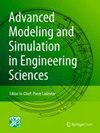Compressible flow simulation with moving geometries using the Brinkman penalization in high-order Discontinuous Galerkin
IF 3.2
Q3 MECHANICS
Advanced Modeling and Simulation in Engineering Sciences
Pub Date : 2020-10-21
DOI:10.21203/rs.3.rs-93466/v1
引用次数: 1
Abstract
In this work we investigate the Brinkman volume penalization technique in the context of a high-order Discontinous Galerkin method to model moving wall boundaries for compressible fluid flow simulations. High-order approximations are especially of interest as they require few degrees of freedom to represent smooth solutions accurately. This reduced memory consumption is attractive on modern computing systems where the memory bandwidth is a limiting factor. Due to their low dissipation and dispersion they are also of particular interest for aeroacoustic problems. However, a major problem for the high-order discretization is the appropriate representation of wall geometries. In this work we look at the Brinkman penalization technique, which addresses this problem and allows the representation of geometries without modifying the computational mesh. The geometry is modelled as an artificial porous medium and embedded in the equations. As the mesh is independent of the geometry with this method, it is not only well suited for high-order discretizations but also for problems where the obstacles are moving. We look into the deployment of this strategy by briefly discussing the Brinkman penalization technique and its application in our solver and investigate its behavior in fundamental one-dimensional setups, such as shock reflection at a moving wall and the formation of a shock in front of a piston. This is followed by the application to setups with two and three dimensions, illustrating the method in the presence of curved surfaces.基于高阶不连续伽辽金的Brinkman惩罚的运动几何可压缩流动模拟
在这项工作中,我们研究了Brinkman体积惩罚技术在高阶不连续伽辽金方法的背景下,模拟可压缩流体流动模拟的移动壁面边界。高阶近似是特别有趣的,因为它们需要很少的自由度来准确地表示光滑解。这种减少的内存消耗在内存带宽是一个限制因素的现代计算系统上很有吸引力。由于它们的低耗散和色散,它们也对气动声学问题特别感兴趣。然而,高阶离散化的一个主要问题是墙体几何形状的适当表示。在这项工作中,我们研究了Brinkman惩罚技术,它解决了这个问题,并允许在不修改计算网格的情况下表示几何形状。几何结构被模拟为人工多孔介质并嵌入到方程中。由于网格与几何无关,该方法不仅适用于高阶离散,而且适用于障碍物运动的问题。我们通过简要讨论Brinkman惩罚技术及其在求解器中的应用来研究该策略的部署,并研究其在基本一维设置中的行为,例如运动壁面的冲击反射和活塞前方冲击的形成。接下来是二维和三维设置的应用,说明了存在曲面的方法。
本文章由计算机程序翻译,如有差异,请以英文原文为准。
求助全文
约1分钟内获得全文
求助全文
来源期刊

Advanced Modeling and Simulation in Engineering Sciences
Engineering-Engineering (miscellaneous)
CiteScore
6.80
自引率
0.00%
发文量
22
审稿时长
30 weeks
期刊介绍:
The research topics addressed by Advanced Modeling and Simulation in Engineering Sciences (AMSES) cover the vast domain of the advanced modeling and simulation of materials, processes and structures governed by the laws of mechanics. The emphasis is on advanced and innovative modeling approaches and numerical strategies. The main objective is to describe the actual physics of large mechanical systems with complicated geometries as accurately as possible using complex, highly nonlinear and coupled multiphysics and multiscale models, and then to carry out simulations with these complex models as rapidly as possible. In other words, this research revolves around efficient numerical modeling along with model verification and validation. Therefore, the corresponding papers deal with advanced modeling and simulation, efficient optimization, inverse analysis, data-driven computation and simulation-based control. These challenging issues require multidisciplinary efforts – particularly in modeling, numerical analysis and computer science – which are treated in this journal.
 求助内容:
求助内容: 应助结果提醒方式:
应助结果提醒方式:


